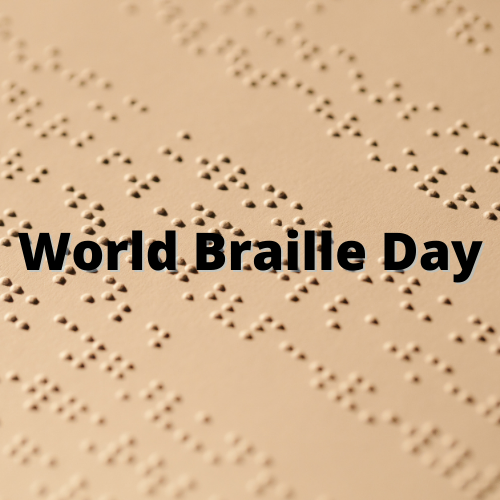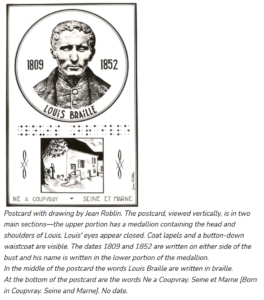
World Braille Day
What is World Braille Day?
World Braille Day occurs annually on January 4th to honor the birth of its inventor, Louis Braille. Braille’s gift to the world has brightened the lives of millions of people around the world who are blind or visually impaired, and they benefit from his work every day. In addition, the day also acknowledges that those with visual impairments deserve the same standard of human rights as everyone else.
What is Braille?
Braille is a tactile representation of alphabetic and numerical symbols using six dots for each letter and number. This method also extends to music, math and symbols for science which makes it possible for a fingertip to feel the entire cell unit with one touch and to move quickly from one cell to the next. Those that are blind and have a vision impairment use braille to read the same books meant for traditional reading.
History of World Braille Day

Louise Braille was a Frenchman who lost his sigh as a child when he accidentally stabbed himself in the eye with his father’s awl. After that, he began spending his time at the Institution for Blind Youth in France. On February 22, 1844, the Institute for Blind Youth in Paris celebrated its move to a new building. During the dedication ceremony, Joseph Guadet demonstrated Louis Braille’s code. First, a 15-page book entitled Account of the System of Writing in Raised Dots Used for the Blind was read to those in attendance.
This text acknowledged Louis Braille’s accomplishments and outlined the steps in the development of his code. During this celebration, a child was sent out of the room and another was asked to use Braille to write poetry by a visitor attending the celebration. Then the first child was asked to come back in the room and read the poetry from the page the second child had created.
The day of the demonstration is often said to be the day Louis Braille’s code, the braille code, was accepted by the world.
World Braille Day Proclamation
World Braille Day was declared an international holiday in November of 2018 with the celebration day of January 4th; Louise Braille’s birthday.
Facts and Figures on Adults with Vision Loss (2019)
2 million adult Americans (or about 13% of all adult Americans) report they either “have trouble” seeing even when wearing glasses or contact lenses, or that they are blind or unable to see at all.
Male vs. Female
- 7 million males
- 5 million females
Age
- 23 million between the ages of 18-64 years of age
- 9.2 million 65 years and older
Race & Ethnicity
- 7 million are white
- 8 million are black or African American
- 4 million are Asian
- 622,000 are American Indian or Alaska Native
- 759,000 indicated other multiple or other races
Marital Status
- 2 million are married
- 4 million have never married
- 2 million are divorced or separated
- 0 million are widowed
- 2 million live with a partner
Education Level (25 years age and over)
- 7 million have less than a high school diploma
- 1 million have a high school diploma or GED
- 2 million have some college education
- 5 million have a bachelor’s degree or higher
Income
- 2 million have a family income of < $35,000
- 1 million have a family income between $35,000-$74,999
- 3 million have a family income between $75,000-$99,000
- 9 million have a family income >$100,000
Definition and scope: The term vision loss refers to individuals who reported that they have trouble seeing, even when wearing glasses or contact lenses, as well as to individuals who report that they are blind or unable to see at all. This estimate pertains to a national sample of the non-institutionalized civilian population 18 years of age and over.
Resources for Healthcare Workers to Better Support People who Are Blind, Low Vision or Deafblind
Test your knowledge: Pre-test and Post-test (after viewing the below videos)
Supporting Individuals with Visual Impairments in the Healthcare Setting, Part One (21 minutes)
Supporting Individuals with Visual Impairments in the Healthcare Setting, Part Two (27 minutes)
Handout: General Overview for Healthcare Workers (PDF)
Dos and Don’ts That Show Respect
- Never grab or push the individual.
- Don’t talk to others who are with the individual, talk to them directly.
- Identify yourself with your name and title, even if you have met before.
- Ask if the individual needs assistance, DO NOT assume.
- Use words like “look” and “see.”
- Ask the individual if they need a human guide. If they say they do, allow them to hold your arm above the elbow. Also, walk a half step in front of the individual.
- Be yourself!
Strategies
- Provide orientation to the physical environment by being specific, not saying unspecific or vision-dependent phrases such as “there” or “like this.”
- Allow the individual to take control of the situation by explaining what they need.
- Explain what you are going to do before you do it. For example, let the individual know before you touch them, when you are moving something, or when you leave the room.
- Ask the individual what information is helpful. Some people like to be know before a needle stick, while others prefer distraction.
- Offer alternatives to regular print; not everyone will be able to read regular print unassisted and may need an electronic or braille copy, or someone to read aloud.
- Offer options for completing paperwork that ensure privacy and acknowledge the individual’s unique preferences. For example, someone might want an electronic version while others require a scribe, that is someone to write for them.
https://www.afb.org/about-afb/history/online-museums/life-and-legacy-louis-braille
https://www.afb.org/research-and-initiatives/statistics
https://www.afb.org/consulting/afb-accessibility-resources/how-make-your-blog-accessible

